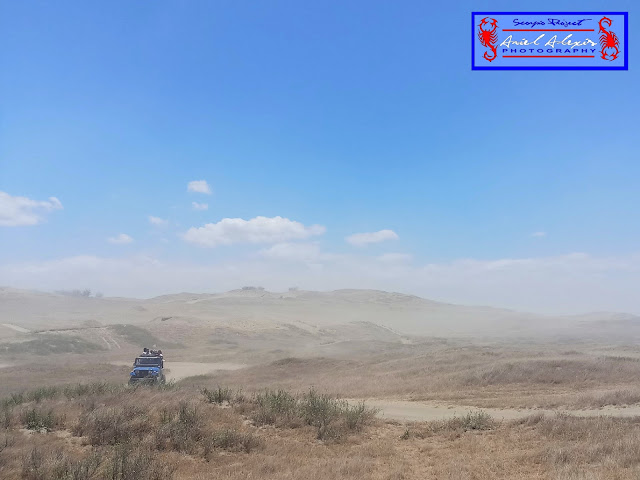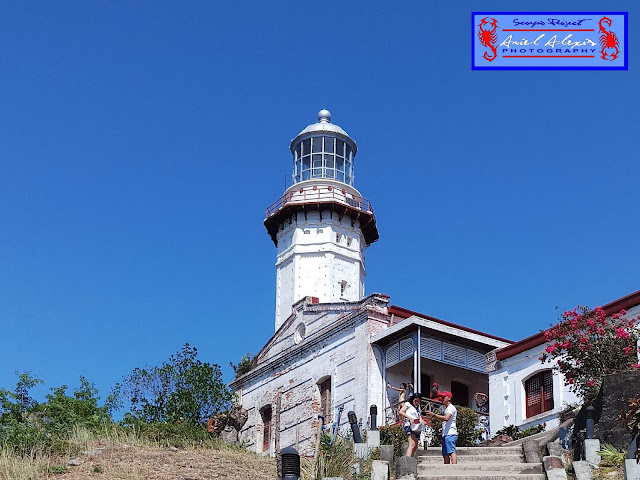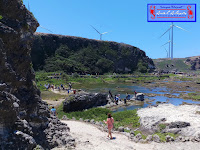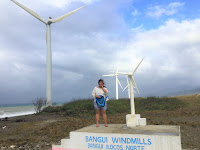Wanna
have some adrenaline rush this summer? Then train your sights up north—and have
some northern exposure in the land of adventure tourism—Ilocos Norte. Embrace
the excitement as you buckle up, grip tight and head out for a ride on the wild
side of the amazing sand dunes! But there are so many reasons why you should
visit the province as there’s much more to it than its overstretched sandy
terrain—although it’s veritably one spectacular attraction where one of my most
unforgettable summer adventures happened!
 |
| Paoay Sand Dunes |

 Yes,
there are numerous reasons why travelers from all walks of life head for this
slice of paradise in the northwestern part of the Philippines—a destination
quite unlike any other. Who can resist
Ilocos Norte’s intoxicating combination of sandy deserts, mysterious rock
formations, craggy promontories, pristine beaches, historical landmarks,
centuries-old churches, and never-ending adventures? Certainly not me and my
friends!
Yes,
there are numerous reasons why travelers from all walks of life head for this
slice of paradise in the northwestern part of the Philippines—a destination
quite unlike any other. Who can resist
Ilocos Norte’s intoxicating combination of sandy deserts, mysterious rock
formations, craggy promontories, pristine beaches, historical landmarks,
centuries-old churches, and never-ending adventures? Certainly not me and my
friends! |
| Hannah's Beach Resort in Pagudpud |
 The
time we spent in Ilocos Norte, most especially in the town of Paoay that I recounted
in my earlier blogs is something that will probably be stored in my memory bank
for quite a long time (For more about my earlier tales on the province, just
click http://scorpio-sojourn.blogspot.com/2018/04/impressed-by-ilocos-nortes-incredible.html and http://scorpio-sojourn.blogspot.com/2018/04/intoxicated-by-ilocos-nortes-sand-dunes.html).
The
time we spent in Ilocos Norte, most especially in the town of Paoay that I recounted
in my earlier blogs is something that will probably be stored in my memory bank
for quite a long time (For more about my earlier tales on the province, just
click http://scorpio-sojourn.blogspot.com/2018/04/impressed-by-ilocos-nortes-incredible.html and http://scorpio-sojourn.blogspot.com/2018/04/intoxicated-by-ilocos-nortes-sand-dunes.html). |
 It was my first time and I ended up loving Ilocos Norte. The people are warm and hospitable. The food is delectable. The diversity of landscapes is awesome. Here’s a place so incredible, so impressive, so inspiring that I was able to come up with three blogs about it. So, let me now continue with this account of our adventures in the province, this time, in the towns of Bangui, Burgos, and Pagudpud.
It was my first time and I ended up loving Ilocos Norte. The people are warm and hospitable. The food is delectable. The diversity of landscapes is awesome. Here’s a place so incredible, so impressive, so inspiring that I was able to come up with three blogs about it. So, let me now continue with this account of our adventures in the province, this time, in the towns of Bangui, Burgos, and Pagudpud. Bangui
Windmills (Bangui). An overcast sky greeted us as our van inched its way
towards the shores facing Bangui Bay where about 20 towering turbines stand in
perfect alignment along the nine-kilometer sandy stretch. When our vehicle
finally came to a halt, a few of us stormed out of it like curious little
children who’ve seen gigantic electric fans for the first time! Armed with our
smartphones and digital cameras, we headed for the beach where the windmills
are.
Bangui
Windmills (Bangui). An overcast sky greeted us as our van inched its way
towards the shores facing Bangui Bay where about 20 towering turbines stand in
perfect alignment along the nine-kilometer sandy stretch. When our vehicle
finally came to a halt, a few of us stormed out of it like curious little
children who’ve seen gigantic electric fans for the first time! Armed with our
smartphones and digital cameras, we headed for the beach where the windmills
are.
 Commissioned
way back in 2005, they’re probably one of the most iconic landmarks of Ilocos
Norte. Operated by a renewable energy company, the NorthWind Power Development
Corporation, the windmills of Bangui provide about 33 MW or half of the
province’s power requirements. Each standing about 70 meters (230 feet),
they’re said to be among the pet projects of former Governor Ferdinand
“Bongbong” Marcos, Jr.
Commissioned
way back in 2005, they’re probably one of the most iconic landmarks of Ilocos
Norte. Operated by a renewable energy company, the NorthWind Power Development
Corporation, the windmills of Bangui provide about 33 MW or half of the
province’s power requirements. Each standing about 70 meters (230 feet),
they’re said to be among the pet projects of former Governor Ferdinand
“Bongbong” Marcos, Jr. |
En route to the beach, I noticed some air-conditioned huts that are said to be available for those who want to stay overnight. At first, it seemed like a good idea spending the night with those windmills until I saw the wild waves that were bashing the shore, accompanied by the strong winds that drove the turbines to work. Hmmm, maybe next time when the winds are calmer. Or do they ever get calm? I thought.
 Forming
a perfect arc reflecting the shoreline of Bangui Bay, facing the West
Philippine Sea, the power-generating structures are a must-see in the province.
For quite some time, the Bangui Windmill Farm was regarded as Southeast Asia’s
largest until its counterpart in the nearby town of Burgos grabbed that title.
Even so, the windmills of Bangui continue to attract the throngs because
they’re more accessible unlike those in Burgos which are spread across the
craggy terrain surrounding the Kapurpurawan Rock Formation.
Forming
a perfect arc reflecting the shoreline of Bangui Bay, facing the West
Philippine Sea, the power-generating structures are a must-see in the province.
For quite some time, the Bangui Windmill Farm was regarded as Southeast Asia’s
largest until its counterpart in the nearby town of Burgos grabbed that title.
Even so, the windmills of Bangui continue to attract the throngs because
they’re more accessible unlike those in Burgos which are spread across the
craggy terrain surrounding the Kapurpurawan Rock Formation.  Geez,
it felt so surreal standing there on that beach on a gloomy afternoon,
taking some snaps with the huge waves, the howling winds and the humongous
monoliths at the backdrop, seemingly conspiring
to re-create a chilling scene from a Hitchcockian thriller. Add some predatory
birds into the picture and that would really scare the wits out of you!
Geez,
it felt so surreal standing there on that beach on a gloomy afternoon,
taking some snaps with the huge waves, the howling winds and the humongous
monoliths at the backdrop, seemingly conspiring
to re-create a chilling scene from a Hitchcockian thriller. Add some predatory
birds into the picture and that would really scare the wits out of you! |
 |
| Kapurpurawan Rock Formation |
Kapurpurawan Rock Formation (Burgos). Nothing prepared me for the amazing rocks of Kapurpurawan when our group visited this incredible wonder in the fringes of Burgos, one the province’s historic coastal towns. If the sand dunes of Paoay made my heart throb with excitement, the Kapurpurawan Rock Formation made it skip a beat with elation as I, together with my travel buddies, basked in its creamy white beauty!
 |

 From
the highway, the rock formation is roughly three kilometers away. After our
vehicle dropped us at the parking area, we started trekking towards the site,
passing through a rugged trail just to see Kapurpurawan up close and personal.
There are horses for hire there but we opted to go on foot so that we can
appreciate the surroundings and take snaps along the way. Other travelers
also braved the hot summer sun to reach the site.
From
the highway, the rock formation is roughly three kilometers away. After our
vehicle dropped us at the parking area, we started trekking towards the site,
passing through a rugged trail just to see Kapurpurawan up close and personal.
There are horses for hire there but we opted to go on foot so that we can
appreciate the surroundings and take snaps along the way. Other travelers
also braved the hot summer sun to reach the site. |

 Bashed
by the wild waves of the West Philippine Sea, this one-of-a-kind marvel is said
to have been formed by various oceanic and weather forces perhaps over
thousands of years. The unique name of the rock formation is said to have been
taken from the Ilocano word, “puraw”, which means white. On a bright day, the
rocks looked resplendent in white as the sun shone upon the natural wonder.
Bashed
by the wild waves of the West Philippine Sea, this one-of-a-kind marvel is said
to have been formed by various oceanic and weather forces perhaps over
thousands of years. The unique name of the rock formation is said to have been
taken from the Ilocano word, “puraw”, which means white. On a bright day, the
rocks looked resplendent in white as the sun shone upon the natural wonder.  |


To
our dismay, the local government has sealed off some parts of Kapurpurawan—a watchman looked after violators and whistled them against climbing
certain portions of it—to stem the tide of vandalism and protect the rock formation from
erosion. Even so, we still had a grand time taking our pics with the Kapurpurawan as our backdrop. Just seeing it up close and personal is definitely worth the
trek!
 |
 |
 |
 |
 |
 |
 |
 |
 |

 Caveat: It’s not advisable to go there close to high noon! It was a case of wrong timing for us when we got to the rock formation as we had to endure the blistering high temperature, which came close to 37 degrees that day! I guess the best time to visit the rocks is early in the morning, say, between 6-9 AM, if you want to be spared from the scorching heat and the swarming crowds.
Caveat: It’s not advisable to go there close to high noon! It was a case of wrong timing for us when we got to the rock formation as we had to endure the blistering high temperature, which came close to 37 degrees that day! I guess the best time to visit the rocks is early in the morning, say, between 6-9 AM, if you want to be spared from the scorching heat and the swarming crowds. |
| Cape Bojeador Lighthouse a.k.a. Burgos Lighthouse |
Cape
Bojeador Lighthouse (Burgos). Although I like seeing old lighthouses, I’m not
really that keen about exploring them. I used to think if you’ve seen one,
you’ve seen them all. Not until I stumbled upon Cape Bojeador Lighthouse,
located in the quaint town of Burgos, which our organizer included in our
Ilocos Norte itinerary. From what I’ve
gathered, it’s not just an ordinary beacon, having been declared a National Historical
Landmark in 2004 and a National Cultural Treasure in 2005.
 Joining the curious crowd who braved the heat and climbed the 164-step concrete
stairway leading to the octagonal stone tower, I, together with some of my
travel buddies, went on a quick trek to the lighthouse. Standing some 20 m (64 ft), the tower is
probably the highest landmark in that part of Ilocos Norte. Nonetheless, Cape
Bojeador Lighthouse isn’t the tallest in the country.
Joining the curious crowd who braved the heat and climbed the 164-step concrete
stairway leading to the octagonal stone tower, I, together with some of my
travel buddies, went on a quick trek to the lighthouse. Standing some 20 m (64 ft), the tower is
probably the highest landmark in that part of Ilocos Norte. Nonetheless, Cape
Bojeador Lighthouse isn’t the tallest in the country. |
| Part of the crowd going up and down the lighthouse |
 |
 |
 |
 |
 |
 |
 |
 Built atop the Vigia de Nagpartian Hill, the monolithic structure dazzles visitors with an unobstructed, panoramic view of the promontory and the sea. Said to have been erected by the Spanish colonizers during the last few years of their rule over the islands, it was first lit by pressurized kerosene lamps on March 30, 1892. Today, its beam comes from a modern electric lamp powered by solar panels.
Built atop the Vigia de Nagpartian Hill, the monolithic structure dazzles visitors with an unobstructed, panoramic view of the promontory and the sea. Said to have been erected by the Spanish colonizers during the last few years of their rule over the islands, it was first lit by pressurized kerosene lamps on March 30, 1892. Today, its beam comes from a modern electric lamp powered by solar panels. |
| Capturing a capture of the lighthouse |
Arriving at the courtyard, we paid a small token (I forgot the amount!) as entrance fee to the lighthouse. At the courtyard, I caught a glimpse of the service buildings and the cistern. A near pyramid-looking stairway led us to the porch of the main pavilion. Overlooking the scenic Cape Bojeador and the West Philippine Sea where galleons used to sail by, the porch is one of the visitors’ favorite spots for selfies, duofies, groupfies and what have you. The pavilion itself has several rooms, most of which have been converted into a museum that featured several artifacts.
 |
 |
 |
 |
 Walking into hallway of the main pavilion, I reached the foot of the covered stairs that lead to the tower’s entrance. That was as far as I went while the other tourists entered the tower. Some of them, however, had to wait for their turn as only a certain number of people are allowed inside at a time.
Walking into hallway of the main pavilion, I reached the foot of the covered stairs that lead to the tower’s entrance. That was as far as I went while the other tourists entered the tower. Some of them, however, had to wait for their turn as only a certain number of people are allowed inside at a time.
Later
in the afternoon, we headed for Pagudpud. Halfway to our destination, a slight drizzle that later turned into heavy rain started falling. The downpour
hardly waned as we reached Maira-ira Cove a.k.a. Blue Lagoon, a cove which boasts of a
creamy white-sand beach. Too bad, inclement weather prevented us from having
fun at Hannah’s Beach Resort and taking some pics at the Patapat Viaduct, both
of which are found in the northernmost part of Pagudpud.
 |
| The road to Pagudpud |
 |
| A playground/theme park at Hannah's Beach Resort |

Add to all the interesting sites and sights I’ve mentioned in this two-part blog the impressive lineup of centuries-old churches dotting many of Ilocos Norte’s quaint towns that will certainly arouse the culture-vulture in you. That’s what I felt after seeing the magnificence of Paoay Church.
 |
| Patapat Viaduct |
 |
| A bus making it through a section of the Patapat Viaduct |
 Days
after our Ilocos escapade, I thought about embarking on a visita iglesia to
take a peek at the old churches in Bacarra, Batac, Laoag, San Nicholas and
Sarrat, among others, in time for Holy Week next year. Now that would be one
helluva good reason for an exciting return to the province!
Days
after our Ilocos escapade, I thought about embarking on a visita iglesia to
take a peek at the old churches in Bacarra, Batac, Laoag, San Nicholas and
Sarrat, among others, in time for Holy Week next year. Now that would be one
helluva good reason for an exciting return to the province! Finally,
the modesty, hospitality and bonhomie of the Ilocanos are something for the
books—they’d really make any vacay in the province truly a pleasant and
memorable one. Take it from me as I’ve personally experienced these myself
during our interactions with the locals that we met along the way. Surely, they’ll
make all those who’ve been there love the province more!
Finally,
the modesty, hospitality and bonhomie of the Ilocanos are something for the
books—they’d really make any vacay in the province truly a pleasant and
memorable one. Take it from me as I’ve personally experienced these myself
during our interactions with the locals that we met along the way. Surely, they’ll
make all those who’ve been there love the province more!


















No comments:
Post a Comment